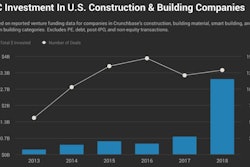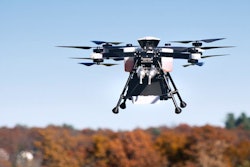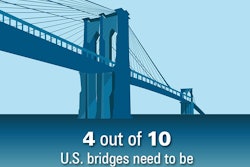
Dynam.AI, a provider of artificial intelligence (AI) solutions, and GBA, provider of engineering and architecture solutions, formed a partnership to identify defects in bridge roadway surfaces. The joint solution uses GBA’s Unmanned Aircraft System (UAS), or drones, and Dynam.AI’s Auguste image detection and classification algorithm with the goal of improving the accuracy, safety and cost effectiveness of infrastructure repairs.
“We are constantly looking for new technologies to solve existing problems, and we found Dynam.AI to be similarly focused on streamlined solutions tailored to a project’s specific needs,” said Tim Ross, president and CEO of GBA. “Working together, we have created a significantly more efficient approach to collect information to substantiate bridge rehabilitation.”
According to a 2019 study from the American Road & Transportation Builders Association, the U.S. has over 47,000 structurally deficient bridges. Traditionally, the collection of data to determine the location and severity of the structural deficiencies has been a manual process requiring ground crews and extensive lane closures, and creating hazards for drivers, road workers and inspectors. The standard approach is costly due to required expenditures on traffic control and other personnel as well as the economic impact of workers stuck in traffic.
In this patent pending methodology, GBA deploys UAS with infrared (IR) thermography to evaluate the condition of concrete decks, overlayments and bridge joints, a feat that was awarded an Engineering Excellence Award by the American Council of Engineering Companies (ACEC) in May of 2019. Dynam.AI’s Auguste detection and analysis algorithm converts GBA’s UAS findings into robust data streams, detecting areas of decay with higher than 85% accuracy and associating that with an understanding of operational costs, timing and the overall impact of repairs. Known for its physics-driven AI models and techniques, Dynam.AI can convert the tremendous amount of data into a 3D model to visualize anomalies. Using this solution is expected to save 70% in man-hours and the process that once took six weeks using the previous technology can now be completed in a matter of days.
“In an environment like bridge rehabilitation, where every percentage point of accuracy counts, precise, consistent and detailed data is paramount,” said David Ferrell, managing director of Dynam.AI. “The integration of our market-leading AI algorithms and techniques with GBA’s extensive expertise in UAS technology results in a cutting-edge solution unmatched in its ability to determine with precision the ideal time for departments of transportation to fix our nation’s decaying infrastructure, allowing them to optimize resource investments and maximize public safety.”
“Using Dynam.AI’s industry-agnostic, platform-enabled solutions, GBA continues to innovate in transportation, as well as across the water, environment, building design, site development, systems integration, and construction management sectors,” said Ben Lindner, Advanced Robotics and Remote Sensing Group Leader at GBA.


















